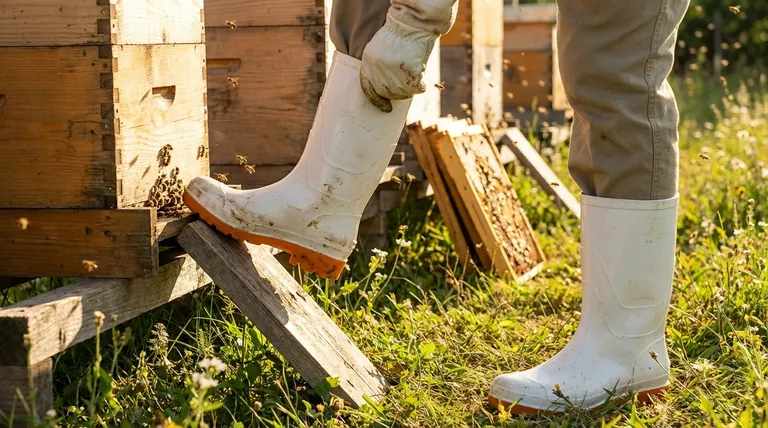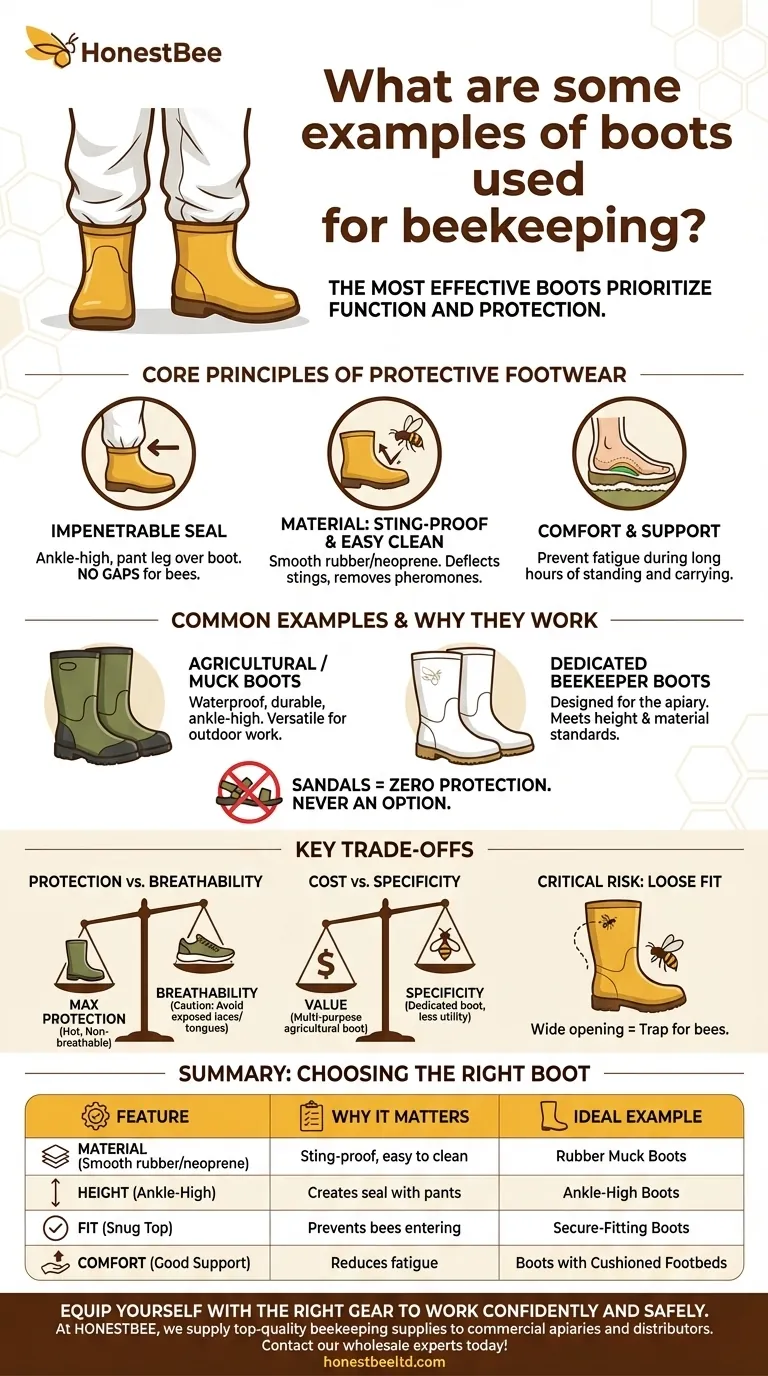The most effective boots for beekeeping prioritize function and protection over any specific brand. Common examples include all-purpose agricultural footwear like Muck Boots or TIDEWE Rubber Neoprene Boots, as well as specialty white beekeeper boots. The key is choosing a boot that provides an impenetrable barrier for your feet and ankles.
The best beekeeping boot is not a specific model but a type: any sturdy, ankle-high boot made from a smooth, impenetrable material like rubber or neoprene. The primary function is to create a complete seal between your pant leg and the boot, ensuring no bees can crawl inside.

The Core Principles of Protective Beekeeping Footwear
To understand what makes a boot suitable for the apiary, you must focus on the principles of protection and practicality. The brand name is secondary to these fundamental requirements.
Ensuring an Impenetrable Seal
The single most important function of your footwear is to prevent bees from accessing your legs. Bees tend to crawl upwards when they feel trapped.
A proper boot must be high enough to cover your ankles completely. Your beekeeping suit or pant legs should be pulled down over the outside of the boots, creating an overlapping seal that leaves no gap for entry.
The Importance of Material
The material of the boot serves two purposes: deflecting stings and ease of cleaning.
Smooth materials like rubber and neoprene are ideal. They are difficult for a bee's stinger to penetrate and are very easy to wipe or hose down, removing any lingering bee alarm pheromones or honey.
Comfort and Support
Working in an apiary often involves standing for long periods and carrying heavy equipment. Your boots should provide adequate support and comfort to prevent fatigue and allow you to focus on your hive inspections.
Common Examples and What Makes Them Work
While any boot that meets the core principles will work, a few types have become popular for their proven effectiveness.
Agricultural & Muck Boots
This is the most common and practical category. Brands like Muck Boots or TIDEWE are simply well-known examples of a style: waterproof, durable, rubber or neoprene boots designed for outdoor work. They are effective because their height and material are perfectly suited for beekeeping.
Dedicated Beekeeper Boots
Some suppliers sell white boots, sometimes with bee emblems. While functionally similar to agricultural boots, they are designed with the beekeeper specifically in mind, ensuring they meet the required height and material standards.
Why Sandals Are Never an Option
Wearing sandals or any open-toed footwear in an apiary is extremely unsafe. It provides zero protection from stings, falling equipment, or the risk of dropping a frame full of bees near your feet.
Understanding the Key Trade-offs
Choosing the right boot involves balancing protection with other practical considerations.
Protection vs. Breathability
Rubber and neoprene boots offer maximum protection but can be hot and non-breathable, especially in warm climates. While leather work boots might seem more breathable, ensure they are smooth and don't have exposed laces or tongues where a bee could get trapped.
Cost vs. Specificity
A dedicated "beekeeper boot" may not offer any functional advantage over a high-quality agricultural boot you can use for other yard work. A general-purpose muck boot often provides better overall value and utility.
The Critical Risk of a Loose Fit
The most significant pitfall is choosing a boot with a wide, loose opening at the top. Even if the material is protective, a loose top creates an open invitation for bees to crawl inside, where they are trapped and likely to sting.
How to Choose the Right Boots for Your Goal
Select your footwear based on your primary needs in the bee yard.
- If your primary focus is maximum safety and ease of cleaning: Choose a tall, snug-fitting rubber or neoprene boot that allows you to securely tuck your pant leg over the top.
- If your primary focus is multi-purpose utility and value: A quality pair of agricultural or waterproof work boots is an excellent choice, provided they are high enough to cover your ankles and create a seal.
- If your primary focus is comfort for long hours: Prioritize boots with good arch support and a comfortable footbed, without compromising on the non-negotiable requirements of height and a secure fit.
Ultimately, the best beekeeping boot is the one that allows you to work confidently and safely, letting you focus on your bees instead of your feet.
Summary Table:
| Feature | Why It Matters for Beekeeping | Ideal Example |
|---|---|---|
| Material | Smooth rubber/neoprene is sting-proof and easy to clean. | Rubber Muck Boots |
| Height | Must cover ankles to create a seal with pant legs. | Ankle-High Boots |
| Fit | Snug top prevents bees from crawling inside. | Secure-Fitting Boots |
| Comfort | Good support for long hours of standing and carrying. | Boots with Cushioned Footbeds |
Equip yourself with the right gear to work confidently and safely. At HONESTBEE, we supply top-quality beekeeping supplies and equipment to commercial apiaries and distributors. Let us help you find the perfect protective footwear for your needs. Contact our wholesale experts today to discuss your requirements!
Visual Guide

Related Products
- Thick PVC Material Waterproof Anti-Slip Wear-Resistant Bee Work Shoes Boots for Garden Outdoor Utility
- Cotton Beekeeping Suit and Round Hat with Veil Bee Keeper Protective Gear
- White Beekeeping Protective Suit and Hat with Fencing Veil for Beekeepers
- Economy Polyester Beekeeping Jacket with Veil and Hat
- Beekeeping Jacket with Hood and Veil for Beekeepers
People Also Ask
- Why is proper footwear important for beekeepers? Ensure Safety & Stability in the Apiary
- What is the importance of ensuring no gaps between pants and boots in beekeeping? Prevent Bee Intrusions & Stay Safe
- What should be considered when choosing beekeeping boots? Ensure Maximum Safety and Comfort
- What are the key characteristics of good beekeeping shoes? Ensure Maximum Protection and Comfort
- Why is ventilation important in beekeeping shoes? Balance Comfort and Sting Protection



















